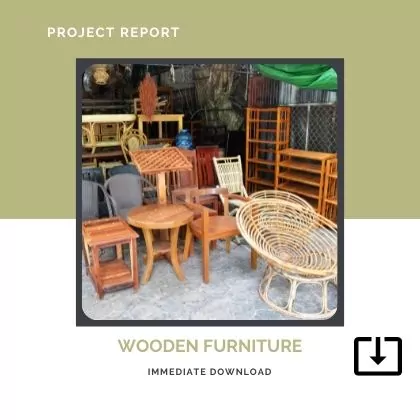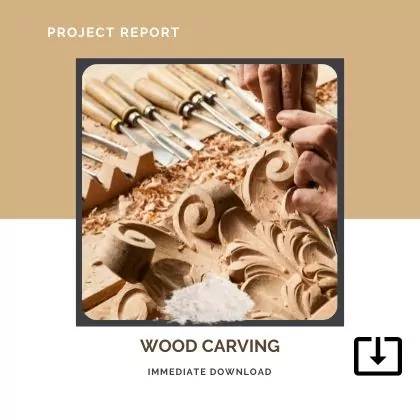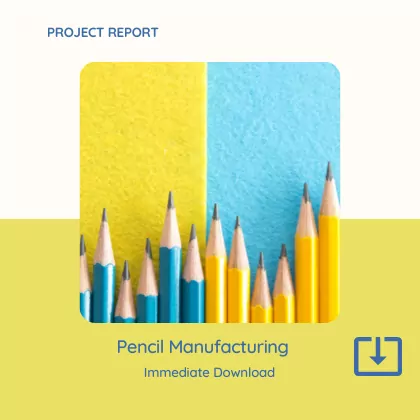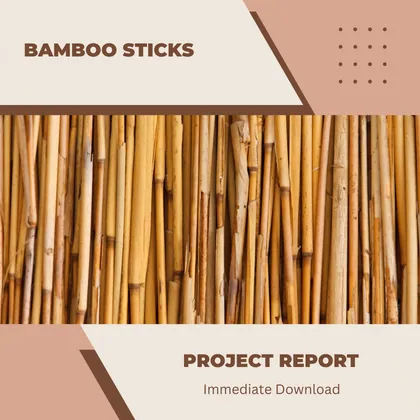Description
Are you planning to start a plywood manufacturing plant? The india plywood business has gained significant popularity and potential profitability in 2021, making it an attractive sector to enter. This comprehensive plywood manufacturing plant project report will guide you through every step, from understanding the market dynamics and estimating costs to setting up the machinery and managing operations. By the end, you’ll have the insights needed to ensure your venture’s success in the plywood industry.
Key Takeaways
Table of Contents
- 1 Key Takeaways
- 2 Introduction
- 3 Overview of Plywood Manufacturing in India
- 4 Market Overview
- 5 Industry Trends and Market Analysis
- 6 Business Opportunity
- 7 Types of Plywood
- 8 Manufacturing Process Step-by-step process
- 9 Required Machinery and Equipment
- 10 Raw Materials Required
- 11 Setting Up a Plywood Manufacturing Plant
- 12 Project Cost Estimation
- 13 Financial Projections
- 14 Licenses and Approvals Required
- 15 SWOT Analysis
- 16 Location Advantage
- 17 Marketing and Distribution Strategy
- 18 Business in India: Challenges and Opportunities
- 19 Environmental Considerations
- 20 Case Studies of Successful Plywood Businesses
- 21 Why Buy Our Project Report?
- 22 Conclusion
- 23 Frequently Asked Questions
- The plywood manufacturing industry presents significant growth opportunities due to increasing demand from the construction and furniture sectors, particularly in emerging markets like India.
- A comprehensive project report is critical for entrepreneurs, detailing cost estimation, market analysis, financial projections, necessary licenses, and effective marketing strategies for establishing a successful plywood manufacturing plant.
- Sustainable practices, including eco-friendly materials and waste management, are essential for compliance with regulations and enhancing the market appeal of plywood products.
Introduction
Plywood, a versatile and essential material, has revolutionized the construction and furniture industries. With its unique properties, including strength, durability, and resistance to moisture, plywood has become the go-to material for builders and designers alike. Its high demand is driven by the booming real estate sector and the ever-growing need for quality furniture.
Starting a plywood manufacturing plant can be a lucrative venture, but it requires meticulous planning and a thorough understanding of the market dynamics. A detailed project report is crucial to navigate the complexities of this business and to ensure a successful and profitable operation. Additionally, the personal satisfaction and financial benefits of starting your own plywood business can be immensely rewarding, making it a popular and potentially profitable endeavor. This guide aims to provide aspiring entrepreneurs with comprehensive insights into setting up a plywood manufacturing plant, from market analysis to financial projections and environmental considerations.
This blog post covers various aspects of the plywood manufacturing business, such as the different types of plywood, the manufacturing process, and the required machinery and raw materials. It also examines financial aspects, including cost estimation and profitability analysis, and discusses necessary licenses and approvals. Case studies of successful plywood businesses are also highlighted to inspire and guide new entrepreneurs.
By the end of this guide, you will understand the plywood industry and the steps needed to establish a successful manufacturing plant. This comprehensive guide will equip both seasoned business owners and newcomers with the knowledge and tools to embark on this venture.
Overview of Plywood Manufacturing in India
Plywood manufacturing in India is experiencing a significant boom, driven by the escalating demand for wood-based products in the construction and furniture sectors. The country boasts a large pool of skilled labor, abundant raw materials, and a favorable business environment, making it an attractive destination for plywood manufacturers. The Indian plywood industry is poised for continued growth, bolstered by government initiatives promoting the use of wood-based products in construction and the rising demand for affordable housing.
India’s diverse climatic conditions and vast forest resources provide a steady supply of high-quality timber, essential for manufacturing plywood. The availability of raw materials like Poplar and Eucalyptus, known for their strength and durability, ensures the production of superior plywood products. Additionally, the government’s focus on sustainable forestry practices and eco-friendly manufacturing processes aligns with global trends, enhancing the market appeal of Indian plywood.
The Indian plywood market is also benefiting from the country’s rapid urbanization and infrastructure development. As more people move to urban areas, the demand for residential and commercial buildings increases, driving the need for durable and versatile building materials like plywood. Furthermore, the growing middle class and their increasing disposable incomes are fueling the demand for high-quality furniture, further boosting the plywood industry.
In summary, the plywood manufacturing industry in India offers immense potential for growth and profitability. With the right strategies and a focus on quality and sustainability, businesses can capitalize on the opportunities in this thriving market.
Market Overview

- Global Growth: The plywood market is experiencing robust growth globally, driven by increasing construction activities and the rising demand for furniture and interior design solutions.
- Indian Market Expansion: In India, the plywood market has shown significant expansion, reflecting the country’s booming real estate and infrastructure sectors, presenting promising opportunities for entrepreneurs.
- Key Demand Sectors: Major demand sectors for plywood include construction, furniture, and interior design, all witnessing substantial growth and contributing to the consistent rise in plywood demand.
- Urbanization and Income Impact: As urbanization and disposable incomes increase, the need for durable and aesthetic building materials continues to grow, further boosting the plywood market.
- Market Competition: Key players in the plywood industry hold a significant market share, yet ample room exists for new entrants to capture a portion of this lucrative market.
- Marketing and Positioning: Effective marketing strategies and an understanding of industry trends are crucial for new businesses to position themselves competitively in the market.
- Investment Opportunities: Emerging markets present additional investment opportunities as they rapidly adopt modern construction techniques and materials.
- Profitability and Growth: Conducting a profitability analysis and understanding market price dynamics can help businesses make informed decisions and achieve sustainable growth.
- Conclusion: The plywood market is ripe with opportunities, and staying updated with industry trends and employing effective marketing strategies can help new businesses thrive. A detailed project report offers essential insights to navigate market complexities and seize emerging opportunities.
Industry Trends and Market Analysis
The Indian plywood market is highly competitive and is expected to grow at a robust CAGR of 10% over the next five years. This growth is primarily driven by the increasing demand for plywood in the construction and furniture sectors. The market is also witnessing a shift towards engineered wood products, such as medium-density fiberboard (MDF) and oriented strand board (OSB), which offer enhanced durability and versatility.
Government initiatives, such as the National Building Code of India, which recommends the use of wood-based products in building construction, are playing a crucial role in driving the market. These initiatives aim to promote sustainable construction practices and reduce the environmental impact of building materials. As a result, there is a growing preference for eco-friendly and sustainable plywood products among consumers and builders.
The market dynamics are also influenced by the rising trend of urbanization and the increasing disposable incomes of the middle class. As more people move to urban areas, the demand for residential and commercial buildings continues to rise, driving the need for high-quality plywood. Additionally, the growing popularity of modular furniture and interior design solutions is further boosting the demand for plywood.
In conclusion, the Indian plywood market presents numerous opportunities for growth and profitability. By staying updated with industry trends and employing effective marketing strategies, businesses can position themselves competitively and achieve sustainable growth in this dynamic market.
Business Opportunity
- Rising Demand: The plywood industry offers abundant opportunities due to the increasing demand for plywood in both rural and urban areas. This demand is driven by the construction and furniture sectors, making it a promising venture.
- Versatility and Applications: Plywood’s versatility and wide range of applications across various industries, such as construction, furniture, and interior design, make it an ad highly profitable business venture.
- Construction Industry Growth: The construction industry has seen a surge in demand for plywood due to its durability, strength, and cost-effectiveness. This growth presents significant opportunities for the plywood and hardware business.
- Government Support: Various government schemes and incentives support wood-based industries, providing financial assistance and subsidies. This support reduces the initial investment required and enhances business profitability.
- Emerging Markets: Starting a plywood business in India is particularly rewarding, given the country’s growing economy and increasing demand for quality building materials. Emerging markets offer numerous investment opportunities for expansion.
- Profit Margins: Understanding market dynamics and using effective marketing strategies allow business owners to capitalize on opportunities and achieve significant profit margins.
- Efficient Resource Management: Leveraging government support enables business owners to manage land and other resources more efficiently, enhancing the overall success of the venture.
- Long-term Growth: Proper planning, a detailed project report, and strategic decision-making are key to navigating the complexities of the plywood business margin and achieving long-term plywood business profit.
In summary, the plywood business presents numerous advantages and growth opportunities. By leveraging government support, understanding industry trends, and employing effective marketing strategies, entrepreneurs can establish a profitable and sustainable plywood manufacturing plant.
Types of Plywood
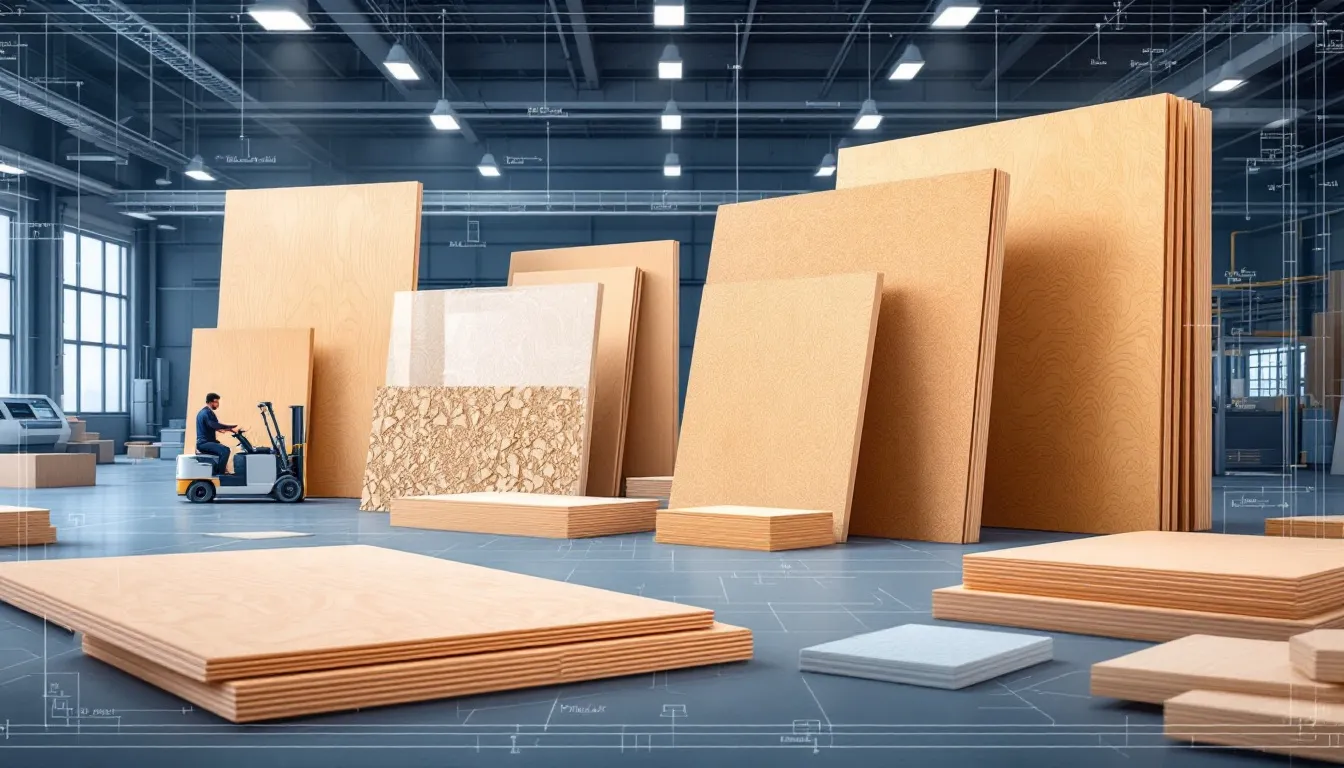
- MR Grade Plywood (Moisture Resistant): Designed for interior applications with limited moisture exposure. Affordable and versatile, commonly used in furniture and cabinetry.
- BWR Grade Plywood (Boiling Water Resistant): Suitable for moisture-prone areas like kitchens and bathrooms. Offers durability and water resistance, ideal for high-quality furniture and construction.
- Marine Plywood: Treated to resist water and fungal attacks. Used in marine applications and environments with constant water exposure, known for its high quality and durability.
- Flexible Plywood: Can be bent and shaped without cracking. Used in interior design and architectural projects for creating curved surfaces.
- Fire Retardant Plywood: Treated to resist ignition and slow fire spread. Essential for construction projects prioritizing fire safety, such as commercial buildings.
Understanding these types helps businesses cater to various needs and enhance profitability by offering the right plywood for specific applications.
Manufacturing Process Step-by-step process
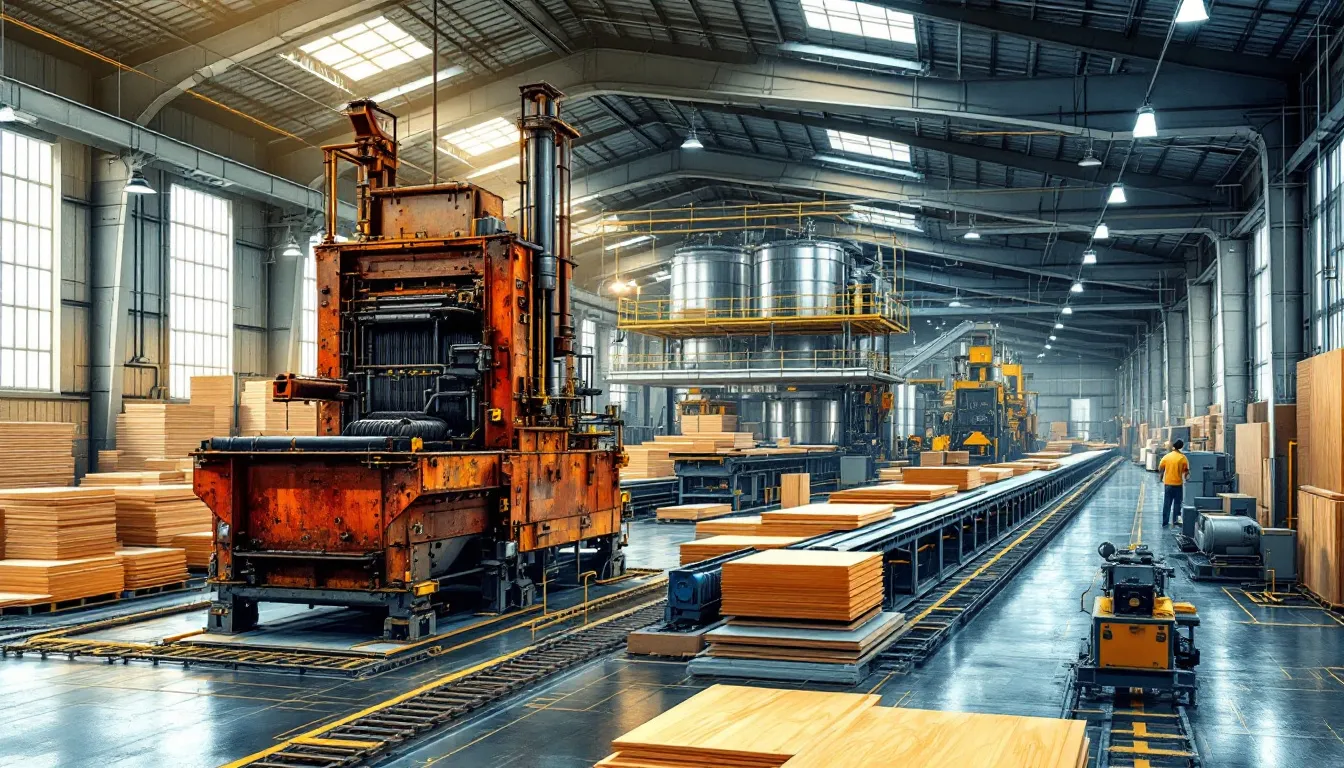
Setting up a plywood manufacturing plant involves a series of well-coordinated production processes. Here is a step-by-step breakdown of the manufacturing process:
- Selection and Debarking of Logs: Choose high-quality raw materials, such as timber logs of Poplar and Eucalyptus, known for their strength and durability. Debark the logs to remove the outer layer, preparing them for further processing.
- Peeling into Veneers: Use a veneer lathe to peel the debarked logs into thin veneers. Ensure the veneers are of uniform thickness for consistent quality.
- Drying the Veneers: Dry the peeled veneers to remove moisture content, preventing warping and ensuring stability. This step is critical for maintaining the quality of the final product.
- Resin Application and Layering: Apply resin to the dried veneers to ensure strong bonding. Layer the resin-coated veneers together to form a plywood sheet.
- Pressing the Veneers: Use a hot press machine to press the layered veneers, creating a solid and uniform sheet. This process enhances the strength and durability of the plywood.
- Trimming and Sanding: Trim the pressed plywood sheets to precise dimensions. Sand the surface to achieve a smooth finish.
- Quality Control Checks: Conduct quality control checks at each stage to ensure the final product meets industry standards and customer expectations.
By following these steps and maintaining strict quality control measures, businesses can produce high-quality plywood that meets market demands and enhances their reputation.
Required Machinery and Equipment
Setting up a plywood manufacturing plant requires a range of machinery and equipment to ensure efficient and high-quality production. Here are the key pieces of equipment needed:
- Log Debarker: Removes bark from timber logs. Ensures wood is clean and free from impurities.
- Veneer Lathe: Peels logs into thin veneers. Ensures uniform thickness for layering.
- Glue Spreader: Applies resin uniformly to veneers. Ensures a strong bond and prevents delamination.
- Hot Press Machine: Presses layered veneers to create solid plywood sheets. Enhances strength and durability.
- Edge Trimming and Sanding Machines: Achieves precise dimensions and smooth surfaces. Ensures plywood meets industry standards.
- Dryers and Finishing Tools: Dry veneers and apply final touches. Maintain product quality and appeal.
Investing in modern technology and high-quality machinery is crucial for optimizing the manufacturing process and maintaining a competitive edge in the plywood market.
Raw Materials Required
- Timber Logs:
- Types: Primarily Poplar and Eucalyptus.
- Qualities: Chosen for strength, durability, and availability.
- Impact: Directly influences the strength and stability of plywood sheets.
- Adhesives and Resins:
- Purpose: Bond veneers together.
- Qualities: High-quality adhesives prevent delamination and enhance durability.
- Treatment Chemicals:
- Purpose: Enhance resistance to moisture, fire, and pests.
- Applications: Used in specialty plywood like fire retardant and marine plywood.
- Packaging Materials:
- Purpose: Transport and store finished plywood sheets.
- Qualities: High-quality materials maintain product integrity during transit.
- Sourcing Strategy:
- Goal: Efficient use of high-quality raw materials to produce superior plywood.
- Benefit: Maintains competitive edge and achieves long-term success in the plywood industry.
Setting Up a Plywood Manufacturing Plant
Setting up a plywood manufacturing plant in India requires a thorough understanding of the market, the availability of raw materials, and the regulatory environment. The plant should be strategically located in an area with easy access to raw materials, such as wood logs, and a skilled labor force. Proximity to timber resources like Poplar and Eucalyptus ensures a steady supply of high-quality raw materials, which is crucial for producing superior plywood products.
Investing in modern machinery and technology is essential for ensuring efficient and high-quality production. Key equipment includes log debarkers, veneer lathes, glue spreaders, hot press machines, and edge trimming and sanding machines. These machines not only enhance production efficiency but also ensure that the final product meets industry standards and customer expectations.
Quality control is another critical aspect of setting up a plywood manufacturing plant. Implementing a robust quality control system ensures that each stage of the manufacturing process is monitored and that the final product adheres to the required standards. This includes conducting regular inspections, testing for strength and durability, and ensuring that the plywood is free from defects.
In summary, setting up a plywood manufacturing plant involves careful planning and investment in high-quality machinery and raw materials. By focusing on quality control and leveraging modern technology, businesses can produce superior plywood products and achieve long-term success in the competitive plywood market.
Project Cost Estimation
Estimating the project cost is a critical step in setting up a plywood manufacturing plant. A detailed project report provides a comprehensive breakdown of the costs involved, helping entrepreneurs plan their investments and manage finances effectively.
The initial cost includes land and building expenses, which can vary significantly based on the location and size of the plant. Securing a suitable location with ample space for production, storage, and future expansion is essential. The cost of land and construction can be a significant portion of the total investment.
Machinery setup is another major expense in establishing a plywood manufacturing plant. Investing in high-quality machinery ensures efficient production and superior product quality. The plywood factory setup cost, along with the cost of equipment, installation, and maintenance, should be carefully planned and budgeted.
Labor and staff costs are ongoing expenses that need to be factored into the project cost estimation. Hiring skilled workers and providing them with adequate training is crucial for maintaining production efficiency and product quality. Additionally, administrative and management staff are needed to oversee operations and ensure smooth functioning.
Working capital is necessary to cover the day-to-day expenses of running the plant, such as raw material procurement, utilities, and other operational costs. Adequate working capital ensures uninterrupted production and helps manage cash flow effectively.
Miscellaneous expenses, such as licenses, electricity, and other utilities, should also be included in the project cost estimation. These costs can add up and impact the overall budget. A detailed project report helps identify all potential expenses and provides a clear picture of the total investment required.
Financial Projections
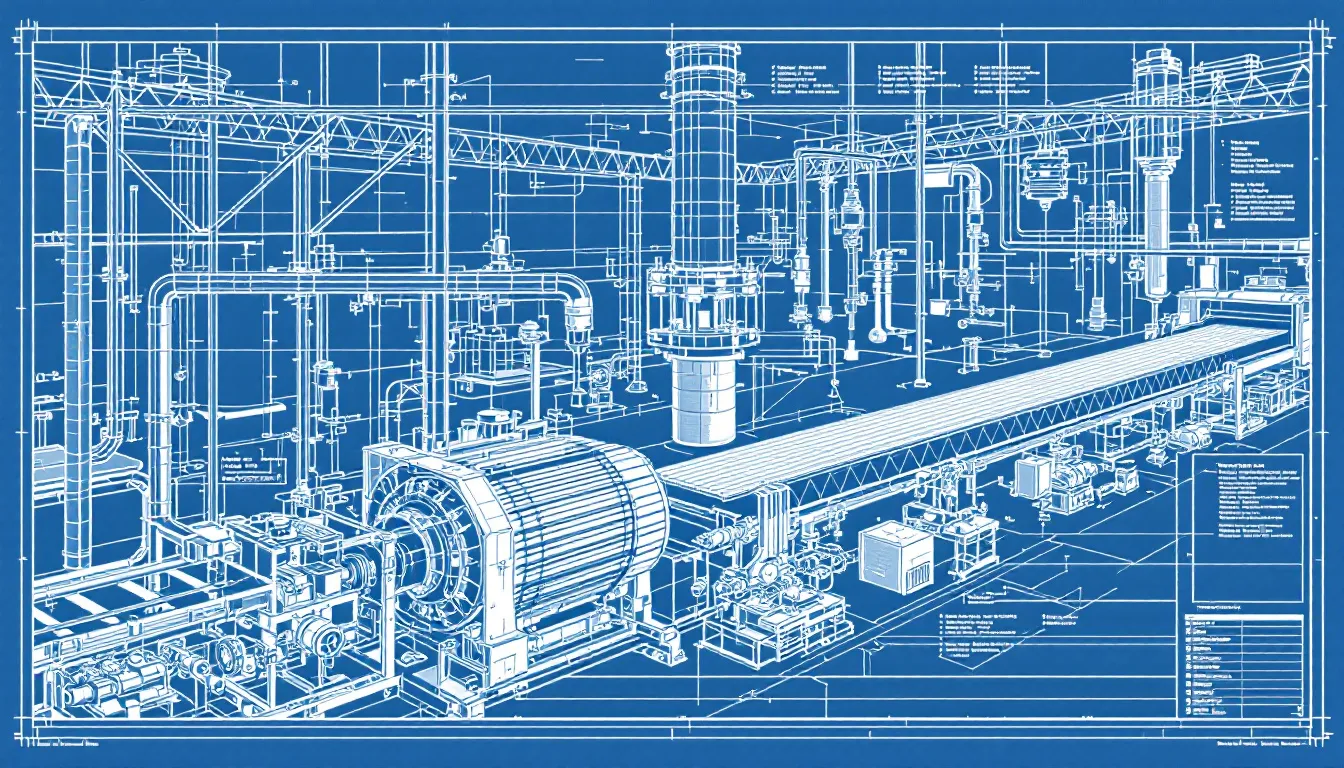
Financial projections are essential for understanding the potential profitability and return on investment of a plywood manufacturing plant. A comprehensive project report includes detailed financial projections, helping entrepreneurs make informed decisions and plan for the future.
The capital investment breakup provides a clear overview of the initial costs involved in setting up the plant. This includes expenses for land, building, machinery, and other infrastructure. Knowing the capital investment required helps secure funding and manage finances effectively.
Sales and revenue forecasts are critical for estimating the plant’s earning potential. These forecasts are based on market analysis, demand trends, and production capacity. Accurate sales projections aid in planning production schedules and managing inventory.
A break-even analysis is an essential part of financial projections. It helps determine the point at which the plant will start generating profits, covering all initial and ongoing expenses. Knowing the break-even point is crucial for setting realistic financial goals and timelines.
Profitability estimates for the next five years provide a long-term view of the business’s financial health. These estimates consider factors such as market growth, price fluctuations, and operational efficiency. A clear picture of future profitability aids in strategic planning and decision-making.
Investment opportunities in the plywood manufacturing industry are abundant, and detailed financial projections help entrepreneurs capitalize on these opportunities. Understanding the potential returns and risks allows business owners to make informed investment decisions and achieve sustainable growth.
Licenses and Approvals Required
- Udyam Registration (MSME): Essential for small and medium enterprises, providing benefits like financial assistance, subsidies, and access to government schemes.
- GST Registration: Mandatory for all businesses involved in the supply of goods and services, ensuring compliance with tax regulations and facilitating smooth operations.
- Pollution Clearance: Required to ensure compliance with environmental regulations, preventing adverse environmental impact and promoting sustainable practices.
- Factory License: Necessary for legal operation, ensuring the plant meets safety and operational standards, maintaining a safe working environment.
- Fire and Safety NOC (No Objection Certificate): Ensures the plant meets safety standards with adequate fire safety measures, protecting employees and assets.
Obtaining these licenses and approvals is crucial for legal compliance and successful operation of a plywood manufacturing plant.
SWOT Analysis
A SWOT analysis is a strategic tool that helps identify the strengths, weaknesses, opportunities, and threats associated with a plywood manufacturing plant. This analysis provides valuable insights for decision-making and risk management, guiding business owners towards success.
Strengths
- High Demand: Plywood is widely used in construction, furniture, and interior design, ensuring a steady market demand.
- Versatility: The material’s versatility allows for a wide range of applications across various industries.
- Modern Technology: Access to advanced machinery enhances production efficiency and product quality.
- Quality Raw Materials: Availability of high-quality raw materials like timber logs ensures the production of superior plywood products.
Weaknesses
- Raw Material Sourcing: Challenges in sourcing quality timber logs can impact production.
- Production Costs: Managing and controlling production costs can be difficult.
- Price Fluctuations: Variability in raw material prices can affect profitability.
- Operational Costs: High operational expenses may pose financial challenges.
Opportunities
- Export Markets: Expanding into international markets offers potential for growth.
- Eco-friendly Alternatives: Increasing demand for sustainable building materials presents new market opportunities.
- Government Support: Various incentives and subsidies can reduce initial investment and enhance profitability.
- Emerging Markets: Growing economies like India provide numerous investment opportunities.
Threats
- Competition: Substitute products like MDF and particleboard can impact plywood demand.
- Environmental Regulations: Compliance with stringent regulations requires investment in sustainable practices.
- Market Dynamics: Rapid changes in market trends and customer preferences can pose challenges.
- Economic Factors: Fluctuations in the economy can affect demand and pricing strategies.
By understanding these aspects through a detailed SWOT analysis, businesses can develop strategic plans to capitalize on strengths and opportunities while mitigating weaknesses and threats.
Location Advantage
- Timber Resource Proximity: Choosing a location near abundant timber resources optimizes raw material sourcing, reducing transportation costs and ensuring a steady supply of high-quality raw materials essential for plywood production.
- Infrastructure and Accessibility: A strategic location with access to major highways, railways, and ports facilitates efficient logistics, ensuring smooth movement of raw materials and finished products, and enhancing the plywood manufacturing plant’s operational efficiency.
- Labor Availability: Selecting a region with a skilled workforce is crucial for maintaining high production standards. Areas with lower labor costs can also reduce operational expenses, contributing to increased plywood business profit margins.
- Established Timber Industry: Setting up a plant in regions with a well-established timber industry provides additional advantages, such as access to skilled labor, existing infrastructure, and potential partnerships with suppliers and distributors.
- Market Access: Proximity to key markets ensures timely delivery of products, reduces logistical challenges, and improves customer satisfaction, which is vital for the success of the plywood and hardware business.
- Plant Layout and Expansion: Adequate space for machinery, storage, and future expansion should be considered when selecting a location. A well-planned plant layout enhances production efficiency and supports long-term business growth.
By carefully considering these factors, business owners can select a location that optimizes production efficiency and reduces operational costs, significantly impacting the success of their plywood manufacturing venture.
Marketing and Distribution Strategy
- Understand Market Dynamics: Analyze market trends and customer preferences to tailor your marketing techniques effectively.
- B2B and B2C Channels:
- B2B: Sell directly to construction companies, furniture manufacturers, and other businesses.
- B2C: Focus on individual customers through retail outlets and online platforms.
- Online Marketing: Establish an online presence with websites, social media, and e-commerce platforms. Use targeted advertising and personalized customer engagement to reach a broader audience.
- Partnerships and Collaborations: Form tie-ups with furniture showrooms and interior designers to enhance market reach. Build brand credibility and attract new customers through industry partnerships.
- Retailer Planning: Understand retailer needs and preferences. Provide high-quality plywood at competitive prices and maintain a reliable supply chain.
- Effective Marketing Strategies: Employ various marketing techniques to boost market presence. Leverage distribution channels for sustainable growth in the plywood manufacturing business.
- Marketing Strategy: Outline specific strategies employed within the plywood and hardware business sector. Provide insights into various approaches and tactics used to effectively promote products and services in this niche market.
Business in India: Challenges and Opportunities
Doing business in India offers a unique blend of challenges and opportunities. The country boasts a large and growing market, a skilled labor force, and a favorable business environment, making it an attractive destination for entrepreneurs. However, navigating the Indian market requires a thorough understanding of the regulatory environment, cultural nuances, and market dynamics.
One of the primary challenges of doing business in India is dealing with bureaucracy and regulatory hurdles. Obtaining the necessary licenses and approvals can be time-consuming and complex. However, the government is making efforts to streamline processes and improve the ease of doing business, which is gradually reducing these challenges.
Corruption and infrastructure constraints are other significant challenges that businesses may face. To mitigate these issues, it is essential to conduct thorough market research, build strong relationships with local partners, and adopt transparent business practices. Additionally, investing in modern technology and efficient logistics can help overcome infrastructure limitations and enhance operational efficiency.
Despite these challenges, India offers numerous opportunities for growth and profitability. The country’s rapidly growing economy, increasing urbanization, and rising disposable incomes are driving the demand for high-quality building materials and furniture. By understanding market trends and customer preferences, businesses can tailor their products and marketing strategies to meet the evolving needs of the Indian market.
In conclusion, while doing business in India presents certain challenges, the opportunities for growth and profitability are immense. By adopting a strategic approach, understanding the market dynamics, and continuously innovating, businesses can successfully navigate the complexities of the Indian market and achieve long-term success.
Environmental Considerations
- Sustainable Practices: Implementing eco-friendly methods in the production process is crucial for minimizing environmental impact and ensuring long-term success in the plywood industry.
- Waste Management: Efficient disposal and recycling of waste materials, such as wood chips and sawdust, are essential to reduce the environmental footprint and comply with regulations.
- Eco-friendly Adhesives: Using environmentally safe adhesives and chemicals can significantly decrease the adverse effects on the environment, contributing to the production of sustainable plywood products.
- Sustainable Logging: Sourcing timber from suppliers who practice sustainable forestry helps maintain ecological balance and ensures a steady supply of raw materials without depleting natural resources.
- Regulatory Compliance: Adhering to environmental regulations not only ensures compliance but also enhances the plant’s reputation as an environmentally responsible business.
- Market Appeal: Focusing on sustainability can improve the marketability of plywood products to eco-conscious customers, enhancing the plant’s overall market appeal.
By concentrating on these key factors, businesses in the plywood industry can effectively promote sustainability and reduce their environmental impact, aligning with industry trends and customer expectations.
Case Studies of Successful Plywood Businesses
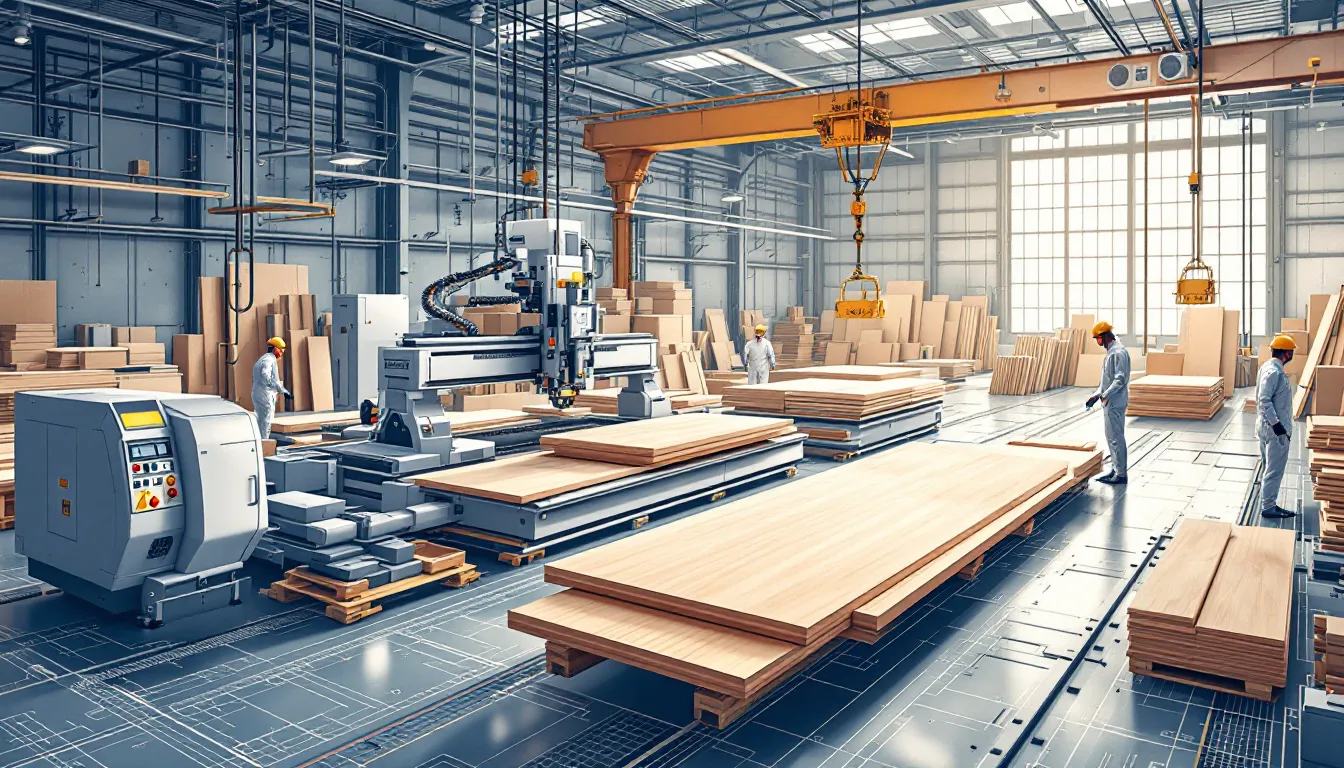
- Valuable Insights: Successful case studies offer crucial insights and inspiration for aspiring entrepreneurs in the plywood industry, highlighting key success factors and strategies for profitability.
- Market Dynamics and Strategies: Entrepreneurs have successfully established plywood businesses by understanding market dynamics and employing effective marketing strategies, focusing on quality, innovation, and customer satisfaction.
- Wholesale Business Success: Building strong relationships with suppliers and customers has enabled individuals to find success in the wholesale plywood business. Bulk orders and long-term contracts ensure a steady revenue stream.
- Technological Investment: Successful wholesalers invest in modern technology and efficient production processes to enhance competitiveness and maintain high-quality standards.
- Greenply Industries Ltd: As a prominent player in the plywood market, Greenply Industries Ltd sets a benchmark with its commitment to quality, innovation, and sustainability, achieving significant market share and brand recognition.
- Western India Plywoods: Known for producing high-quality products and maintaining sustainable practices, Western India Plywoods offers valuable lessons for new entrepreneurs aiming to establish a successful plywood manufacturing plant.
- Strategic Planning: These success stories underscore the importance of strategic planning and market research in achieving growth and profitability in the plywood industry.
Why Buy Our Project Report?
- Comprehensive Insights: Our project report provides detailed insights into the costs, market analysis, and financial projections necessary for starting a plywood manufacturing business.
- Informed Decision-Making: It helps entrepreneurs make informed decisions by covering all critical aspects of the business, from raw materials to marketing strategies.
- Economic Development: The report outlines strategies for job creation and economic development in the local community through the establishment of a plywood manufacturing facility.
- Sustainable Practices: Emphasizes the importance of using environmentally sustainable practices and government-certified timber, enhancing marketability and compliance.
- Modern Technology: Details modern technology applications that maximize growth with minimal investment, optimizing operations and increasing profitability.
- Market Demand Analysis: Includes a comprehensive analysis of potential market demand, highlighting the eco-friendliness of plywood compared to plastic alternatives.
- Strategic Planning: Provides a roadmap for strategic planning and navigating the complexities of the plywood industry, helping businesses achieve a competitive edge.
- Risk Mitigation: Helps identify and mitigate potential risks, ensuring a smoother path to success in the plywood manufacturing venture.
Conclusion
In conclusion, setting up a plywood manufacturing plant offers several advantages and opportunities for growth. A comprehensive project report is essential for understanding the market dynamics, estimating costs, and planning for the future. Leveraging the report’s insights helps entrepreneurs avoid common mistakes and achieve long-term success.
Proper planning and strategic decision-making are key to the success of a plywood manufacturing business. Understanding the various aspects of the business, from raw materials to marketing strategies, helps in making informed decisions and optimizing operations. By focusing on quality and sustainability, businesses can enhance their market presence and profitability.
Encouraging entrepreneurs to start with proper planning, the project report provides a roadmap for navigating the complexities of the plywood industry. Following the report’s guidelines and recommendations helps new businesses achieve a competitive edge and sustainable growth.
The plywood industry offers a wealth of opportunities for aspiring entrepreneurs. With the right approach and a detailed project report, business owners can embark on this venture and achieve significant success. The insights and strategies provided in the report serve as a valuable resource for navigating the challenges and capitalizing on the opportunities in the plywood market.
Frequently Asked Questions
What are the primary raw materials required for plywood manufacturing?
The primary raw materials required for plywood manufacturing are timber logs, particularly Poplar and Eucalyptus, along with adhesives, resins, treatment chemicals, and packaging materials. These components are essential for producing high-quality plywood.
What are the different types of plywood, and where are they used?
There are several types of plywood, including MR Grade, BWR Grade, Marine Plywood, Flexible Plywood, and Fire Retardant Plywood, each suited for specific applications such as interior use, moisture-prone areas, marine environments, curved surfaces, and fire-sensitive locations. Selecting the appropriate type ensures optimal performance and longevity in various conditions.
What are the key steps in the plywood manufacturing process?
The plywood manufacturing process involves several key steps: selecting and debarking logs, peeling and drying veneers, applying resin, layering, pressing, trimming, sanding, and conducting quality checks. Each step is crucial to ensure the final product meets industry standards.
What licenses and approvals are required to start a plywood manufacturing plant?
To start a plywood manufacturing plant, you will need Udyam Registration (MSME), GST registration, pollution clearance, a factory license, and a fire safety NOC. Ensuring these licenses and approvals are in place is crucial for legal compliance and successful operation.
Why is a detailed project report important for starting a plywood manufacturing business?
A detailed project report is essential for starting a plywood manufacturing business as it offers critical insights into costs, financial projections, and market analysis. This documentation enables informed decision-making, minimizes risks, and supports the pursuit of long-term success.


